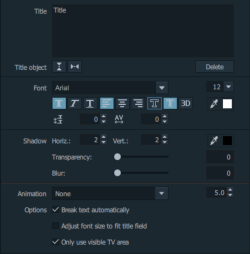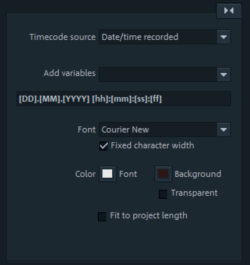Title
Titles can be used for many applications: as a running text (ticker), subtitles, speech and thought bubbles, to display date and time, and much more.
Create titles without a template
-
Select the object to which you want to add a title.
-
Place the playback marker at the position in the object where the title should appear.
NOTE You can adjust this position later at any time by dragging and dropping the title object.
-
To do this, click the "Title" button in the toolbar.
-
Enter your text and click the check in the input field of the program monitor.
-
Click in the program monitor and movie the title to the position in the image where it should appear.
-
Format the title via the title editor in the Media Pool.
Creating titles using a template
There are a wide range of title templates for fonts, opening and closing credits, captions etc. under "Title Templates" in the Media Pool.
-
Select any title template. Start a preview or add a title to a playback marker location using the quick access feature.
NOTE Templates may be applied to an existing title object. Only the text will remain when the template is applied; all other formatting settings will be replaced by the template settings.
Dynamic titles
This category "Dynamic titles" contains standard text animations, such as flying letters which combine to form text and wave animations which move through the individual letters of words.
After selecting a template, you can enter text and then customize font type, font size, color and emphasis (bold, italics, underlining).
-
From the Media Pool, select the desired title under "Title templates > Dynamic titles". Once you've imported it to the film, you will automatically switch to the area "Effects > Title editing".
-
Adjust the text, as well as font, size, color and style in the title editor as desired.
Fade in date as title
Video Pro X is also able to insert the time and date into the image material. To do this, select the option "Show date as title" in the video object's context menu.
If a DV-AVI file is involved (e.g. a digital recording from a camcorder), then the recording date for the selected position will be used. If another type of file is involved, then the creation date of the file will be used as the timecode. The title editor is then opened in order to customize the entry.
Positioning titles and adjusting frame size
-
Click once on the title in the program monitor to access the positioning frame. Simply move the positioning frame using drag and drop.

-
The size of the positioning frame can be adjusted at the corners, and the size of the text will also change accordingly. If "Adjust font size to title field" is activated, the text size will also change.
Title Editor
You can determine the appearance of your titles in the title editor (in the Media Pool under "Effects > Title editing").
You can customize the text properties for multiple selected text objects at once. The settings will only be applied to the text objects you have selected. The individual properties of each text object remain unchanged.

The following editing options are available for selection:
 Here you can enter text for your title instead of editing it directly in the program monitor.
Here you can enter text for your title instead of editing it directly in the program monitor.
Title Object
 The left button vertically centers the title object on the monitor; the right centers it horizontally.
The left button vertically centers the title object on the monitor; the right centers it horizontally.
Delete: Deletes the selected title object
 Use the arrow keys in the title editor to move from one title object to the other without having to search in the project window. Captions are not included in this.
Use the arrow keys in the title editor to move from one title object to the other without having to search in the project window. Captions are not included in this.
Font
Here you can determine the font type and size of the title. If you click on the small arrow next to the font size, you can change the font size using a smooth slider.
You can set format properties in the toolbars below.
 Bold/Italic/Underlined
Bold/Italic/Underlined
 Left-aligned/Centered/Right-aligned
Left-aligned/Centered/Right-aligned
 Shadow
Shadow
Transparency: Controls foreground transparency levels.
Soften: Makes the edge of the shadow harder or softer.
 Outline
Outline
Width: Enter the width of the frame in points.
Filled in: The text will be filled with the color selected in the Title Editor. If the option is deactivated, only the frame will be visible, and the background will appear instead of the color fill.
 3D
3D
The text appears with a 3D-style outline. The width and thickness of the 3D contour (height) can be set in points.
 X3D: If MAGIX 3D Maker is installed on your computer, another button will appear for 3D titles.
X3D: If MAGIX 3D Maker is installed on your computer, another button will appear for 3D titles.
The title object will now be turned into a MAGIX 3D Maker object and 3D Maker will open to begin editing..
 Font color
Font color
 Line spacing: Cannot be applied to only one line. When applied to multiple lines, this alters the spacing between the lines. Line spacing always applies to the entire line.
Line spacing: Cannot be applied to only one line. When applied to multiple lines, this alters the spacing between the lines. Line spacing always applies to the entire line.
 Tracking: Controls the spacing between characters. Negative values move the characters closer together, positive values move them apart.
Tracking: Controls the spacing between characters. Negative values move the characters closer together, positive values move them apart.
Animation
Here you can set four movement directions to move the title on the image. You can also set any course of movement. See Working with Keyframes for more information.
Other text settings
Automatic text break: Separates text automatically when the end of the text field is reached.
NOTE The result will be seen once you have confirmed the entered text by ticking next to the selection box or by pressing the Enter key.
Adjust font size to title field: Changes the font size according to the text field size. You can activate or deactivate this option temporarily by pressing the shift key while dragging the text field handles.
Only apply visible TV area: The text will be zoomed so that it will always be within the TV's screen area, which is specified in the Movie effect settings.
Notes on background color
To add background color for text with no other video or image objects as background, click "Background design" in the context menu for the text object.
Timecode
Under "Templates > Title templates" in the "Timecode Basic" section, you will find various presets that you can use for displaying the timecode. This function adds a special timecode object to a free track under the video object.
You can adjust the position of the timecode by moving the timecode object in the program monitor. The handles on the borders can be used to adjust the length.
Presets can be customized in "Effects > Title editing > Timecode".

Timecode source: The type of timecode can be selected here. The following options are available:
-
Movie time: The time position in the Video Pro X Arranger.
-
Object time: The time position within the timecode object independent of the movie length and the position in the arrangement.
-
Recording date/time: The date and time when the footage was recorded. This timecode information must be saved in the video, otherwise the display will be empty.
-
Recording timecode: The timecode for the video that is created by the camera. This timecode information must be saved in the video, otherwise the display will be empty.
NOTE If the recording date/time and the timecode are not saved in the source material, only placeholders in the form of "-" will be displayed.
Add variable: The date/time format of the selected preset will be displayed as variables in the format line (square brackets define a variable). These can be deleted or additional ones can be added. You can also add your own text and adjust the separators between variables.
Font: Select a font.
Fixed character width: For fonts with variable character width (proportional fonts), the display will change during playback because, for example, "1" is narrower than "0". Here you can hide these types of fonts from the selection list.
Color: You can set the font and background color here. If "transparent" is activated, the background will be transparent.
Adjust to project length: Adjusts the length of the timecode object to match the length of the project to ensure that it is displayed at all times.
Counter start/Progress: If you have inserted a counter as a variable or are using a preset, you can regulate how it behaves here. For example, the counter can start with 10 and continue in intervals of 5. If you would like the counter to count backwards, enter a minus sign in front of the number in the "Progress" field.